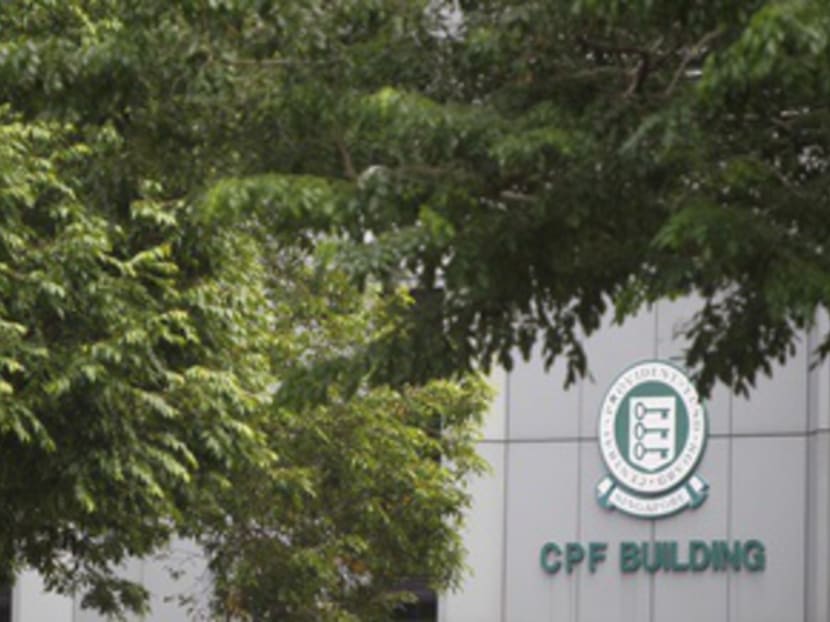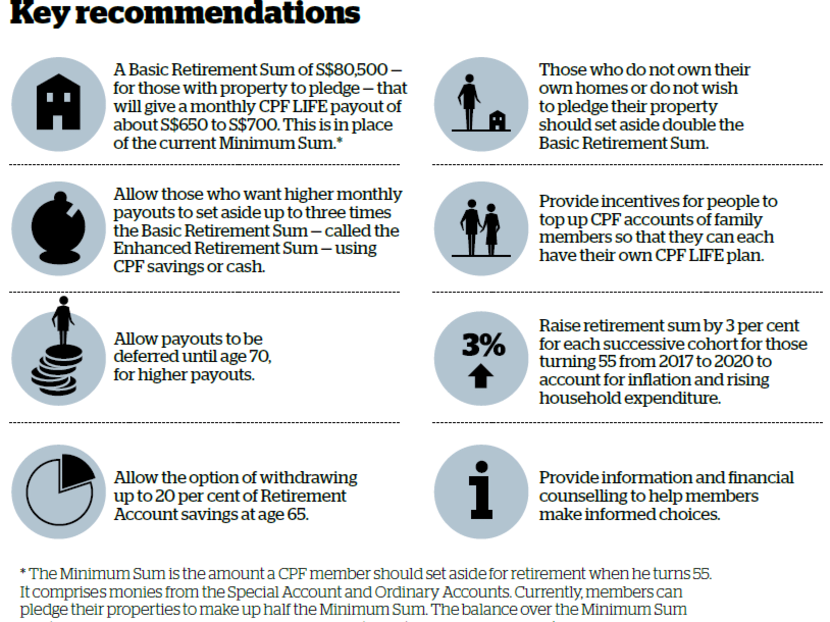Simpler, more flexible CPF scheme proposed
SINGAPORE — It was given the task of reviewing how the Central Provident Fund (CPF) nest egg could give Singaporeans a basic monthly payout for life, while allowing for lump sums to be withdrawn in members’ golden years. Yesterday, the 13-member CPF advisory panel unveiled its first tranche of recommendations, which aimed to provide “adequacy, simplicity and flexibility”, and placed a greater focus on payouts in retirement.
SINGAPORE — It was given the task of reviewing how the Central Provident Fund (CPF) nest egg could give Singaporeans a basic monthly payout for life, while allowing for lump sums to be withdrawn in members’ golden years. Yesterday, the 13-member CPF advisory panel unveiled its first tranche of recommendations, which aimed to provide “adequacy, simplicity and flexibility”, and placed a greater focus on payouts in retirement.
Among other proposals, the Minimum Sum scheme will be jettisoned. A new Basic Retirement Sum will take its place: The panel recommended that Singaporeans retiring in 2026 set aside enough for basic payouts of S$650 to S$700 per month, which would mean having S$80,500 in their Retirement Account when they turn 55 next year. Called the Basic Retirement Sum, the amount is half of the Minimum Sum of S$161,000 for Singaporeans who turn 55 from July. CPF members may opt to place more funds into their RA for higher payouts later.
The panel — which was set up last September — also recommended locking in the quantum of increase for the Basic Retirement Sum early, compared with the Government’s current practice of adjusting the Minimum Sum annually to account for inflation.
It also gave a nod to a proposal — first floated by Prime Minister Lee Hsien Loong during last year’s National Day Rally and also put up by the National Trades Union Congress — to allow CPF members to make a lump sum withdrawal of up to 20 per cent of CPF savings upon reaching 65. However, it cautioned that people should exercise the withdrawal option with care.
The panel’s proposals, which form the first of two sets of recommendations, have already been accepted by the Government. In a letter to the panel, Manpower Minister Tan Chuan-Jin said details on the CPF changes, as well as a new Silver Support scheme giving bonus payments to those with low CPF balances, will be announced during the Budget presentation this month or in the ensuing Committee of Supply debates.
Panel chairman Tan Chorh Chuan said the payouts under the Basic Retirement Sum are in line with the lower-middle-retiree household spending per person, with inflation factored in. Given that this sum will be the baseline for most CPF members, the panel opted for a level that is reasonable and attainable by the majority, said Professor Tan, who is also the president of the National University of Singapore.
While the Basic Retirement Sum will be the most relevant sum for the majority, Prof Tan said the flexibility to allow members to put in more money in their Retirement Account would cater to a diverse population that views “basic needs” differently or those who want to draw higher payouts in future.
Panel members shared that focus group participants’ notions of basic expenses ranged from several hundred dollars to a few thousand dollars a month. Asked about the disparity between the proposed basic payouts and payouts of about S$1,200 under the Minimum Sum scheme, Prof Tan said the Minimum Sum payouts were sized for a two-person household with one breadwinner, as was typically the case in the past. There is a growing number of dual-income and single households, and the panel wants everybody to have their own CPF LIFE annuity plan for lifelong retirement payouts. For households with a non-working spouse, incentives could be considered to encourage husbands — who are typically the breadwinners — to transfer some CPF funds to their wives so the latter can also purchase CPF LIFE plans, the panel said.
On the 20 per cent lump sum withdrawal cap proposal, the panel said it was a threshold they were comfortable with. CPF members could have shorter-term cash needs, but withdrawals should be made knowing that monthly payouts will decrease, it added.
This should take place at age 65, the same age at which they are eligible for payouts, the panel proposed.
On the question of whether this could be too late, given Singapore’s retirement age of 62 and the possibility that older workers may not be offered re-employment, Prof Tan said people are living longer and there is a need to provide monthly payouts for a longer period of time. There are efforts by the Government to help older workers find employment as well as other forms of assistance, he said. CPF members who are unable to work may also withdraw CPF savings earlier on medical grounds under current provisions.
Turning to why the panel recommended a cap of S$241,500 next year — three times the Basic Retirement Sum — to be used for CPF LIFE premiums, panel member Colin Pakshong said the annuity scheme is supported by special government bonds, with premiums and corresponding payouts that would be difficult for commercial insurers to offer. The bond issuers need to balance their budgets, said panel member Joseph Cherian.
But even with the Enhanced Retirement Sum set at three times the Basic Retirement Sum, almost nine in 10 of all CPF members turning 55 today will be able to commit all their CPF savings accumulated in their working lives to receive CPF LIFE payouts — should they choose to do so.
On whether the flexibility to put more money in the Retirement Account would inadvertently benefit the well-off more, the panel said higher or extra interest is earned on lower balances under the existing system.
The panel made clear that its proposals were meant to enhance a system that is fundamentally sound and already well-placed to enable active workers to save enough for retirement. The recommendations will offer a range of options to people with different needs, Prof Tan said.
Work continues on the panel’s second set of recommendations, on options for CPF payouts to rise with time to address the cost of living, and providing flexibility to members who wish to seek higher returns and take higher risks. These will be submitted later this year.








